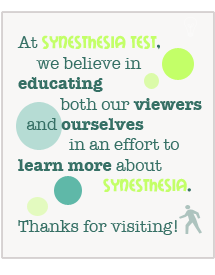The Synesthesia Battery – Test & Research Center

When it comes to standardized testing for synesthesia, you won’t find a more well developed, comprehensive collection of questions and tasks than the Synesthesia Battery. Developed in the laboratory of neurologist, Dr. David Eagleman, at the Baylor College of Medicine, the Battery provides individuals with a secure experience that fosters education and research on synesthesia. If you’re unfamiliar with Dr. Eagleman’s work, I recommend reading his and Richard E. Cytowic’s book – Wednesday Is Indigo Blue: Discovering the Brain of Synesthesia. It’s a great read and provides some awesome insights into the mind of a synesthete. So, yeah, read it! 🙂
Testing for Synesthesia
Since most of you are here to find a test for synesthesia, I’ll first direct you to the Battery’s preview questionnaire, which should give you a general idea of whether or not you’re a synesthete. It consists of seven relatively straightforward questions, so don’t be intimidated. Just answer to the best of your ability. After you’ve answered the questions, click ‘Continue’ to see your results! If it turns out that your answers indicate that you might experience some forms of synesthesia, you’ll be greeted with a form through which you can sign up (for free) for the full battery of tests.
Wondering what the tests are like? You’re in luck! The Battery provides a pretty extensive preview of the questions/tests that you’ll encounter once you sign up, along with some demos to try out. The demos are pretty simple, but they give you a good idea of how things operate within the actual battery of tests. This grapheme-color demo, for instance, only illustrates the first portion of a multi-faceted test – but it does a good job of introducing the user to the general testing process.
Synesthesia Research
Testing is one thing, and it’s great for you – the user – but it’s all the more awesome when the results are used responsibly for research and development. The Synesthesia Battery provides researchers with secure standardized testing for their synesthetic subjects. All information, including test results, is kept private for each subject. Those being tested can specify an additional email (in most cases, the email of the researcher) to which they would like to grant access. This way, the researcher can log into synesthete.org (using the credentials that are emailed to him/her), and access the results of the test subject. Pretty cool, right?
Want to learn more about synesthesia research and the Synesthesia Battery? Check out this article/video from the Huffington Post, in which researcher Steffie Tomson talks about her research on synesthesia in Dr. Eagleman’s lab. It’s well worth a read/watch!
That’s all for now, everyone! Remember, if you have a vested interest in synesthesia, you might consider checking out Dr. Eagleman’s (and Richard Cytowic’s) book: Wednesday is Indigo Blue. It’s a great way to develop a more comprehensive understanding of synesthesia. Thanks, as always! See you next time! 🙂
What are your thoughts on synesthesia research? What tendencies might you explore if you had access to synesthetic test subjects? Let us know in the comments section!





I’m not really sure what my results mean. It listed ten different “types of synesthesia you have” then 3 “movement ->piano scale” (not sure what that meant) then said my VVIQ-2 score was 2.4375. my PA was 0, i understood what that meant. but as for the other parts I think I need i dumbed down a bit. can you do that for me? Please
I’m not sure from this that I am have synesthesia at all, but I do have an above command of relative pitch, and I get a reaction which I can’t explain when I hear songs I like a lot — and I’m finding out that a lot of other people don’t have. I may need some help here.
A PRONOUNCED DEGREE OF SYNESTHESIA MUST HAVE BEEN A CHARACTERISTIC OF THE FIRST PEOPLE TO SPEAK VERBALLY
Synesthesia is always present in people for whom a melody heard long ago brings the associated scene vividly to mind
A simple color picker doesn’t quite work for me because it shows as inconsistent when it really is consistent. For example some letters such as B and E aren’t a simple color, it’s like when you’re snow-blinded or have been staring at a bright light for a long time and then look away- that sort of cloudy mixture of blue, green, and purple and it’s kind of hard to pinpoint exactly what solid color it is.
The test seemed to exclude any syn but color. My syn involves the taste of numbers, but the survey emphasised only experience = syn color, so I wasn’t able to complete 9/10 of the survey as your queries simply didn’t apply . Disappointing.
Do I have synesthesia